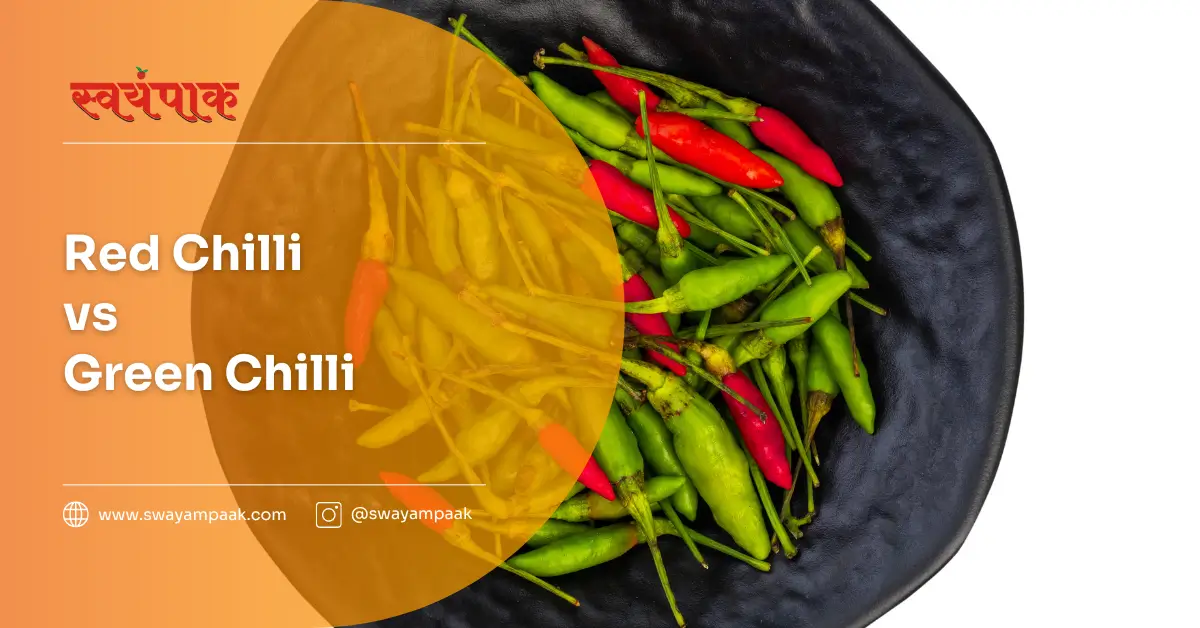Chilli peppers, a staple in many cuisines worldwide, come in a variety of colours, shapes, and heat levels. Two of the most common types of chilli peppers are red chilli and green chilli. While they may look similar, they offer distinct flavours and heat intensities.
In this article Red Chilli vs Green Chilli, we will delve into the differences between red chilli and green chilli, exploring their characteristics, nutritional value, and common uses in cooking. Let’s discover which type of chilli pepper is the perfect fit for your spicy culinary creations!
Key Takeaways from the Red chilli vs Green chilli
- Colour matters: Red chilli peppers are typically red, while green chilli peppers are typically green, but both can vary in colour.
- Heat level varies: Red chilli peppers generally have a higher heat level than green chilli peppers, but both can range from mild to spicy.
- Flavour profile differs: Red chilli peppers offer a more intense, spicy flavour, while green chilli peppers have a fresher, tangier taste.
- Both are nutritious: Both red and green chilli peppers are low in calories and high in vitamins and minerals.
- Versatility: Both can be used in a variety of dishes, from sauces and curries to pickles and stir-fries.
- Choose based on desired heat level: If you prefer a milder flavour, opt for green chilli peppers. For a spicier kick, choose red chilli peppers.
- Experiment with both: Try different varieties of red and green chilli peppers to discover your personal preferences.
The Fiery World of Chilli Peppers: Red Chilli vs Green Chilli
Chilli peppers, a member of the nightshade family, have been used as a spice and condiment for centuries. They are known for their vibrant colours, pungent aroma, and fiery heat. chilli peppers are native to the Americas and were introduced to other parts of the world through trade and exploration.
Purpose of the Comparison
This blog post aims to explore the key differences between red chilli and green chilli, two popular varieties of chilli peppers. By understanding their characteristics, flavour profiles, and nutritional value, you can make informed choices when adding spice to your dishes. We will compare their colour, heat level, common uses, and health benefits to help you determine which chilli pepper is the best fit for your culinary creations.
Red chilli: A Fiery Flavour
Characteristics and Appearance
Red chilli peppers are typically bright red, although they can also vary in shades of orange, yellow, or brown. They are elongated in shape and can range from small and slender to large and fleshy. The heat intensity of red chilli peppers can vary significantly depending on the variety.
Flavour Profile
Red chilli peppers are known for their pungent, spicy flavour. The heat level can range from mild to extremely hot, depending on the specific type of red chilli. Some common red chilli varieties include jalapeños, cayenne peppers, and habaneros.
Nutritional Value
Red chilli peppers are low in calories and high in vitamins and minerals. They are a good source of vitamin C, vitamin A, potassium, and antioxidants. Capsaicin, the compound responsible for the spicy flavour, has also been linked to various health benefits, such as pain relief and improved metabolism.
Common Uses in Cooking
Red chilli peppers are a versatile ingredient used in a wide range of cuisines worldwide. Here are some common uses:
- Sauces and condiments: Red chilli peppers are used to create spicy sauces like salsa, sriracha, and tabasco.
- Curries and stews: They add heat and flavour to curries, stews, and other savoury dishes.
- Pickles and preserves: Red chilli peppers can be pickled or preserved for a tangy and spicy flavour.
- Toppings: Sliced or crushed red chilli peppers can be used as a topping for tacos, pizzas, and other dishes.
- Spices: Dried red chilli peppers are often used as a spice to add heat and flavour to dishes.
Green chilli: A Fresh and Tangy Flavour
Characteristics and Appearance
Green chilli peppers are typically green in colour, although they may turn red or yellow as they ripen. They can vary in size and shape but are often smaller and more slender than red chilli peppers.
Flavour Profile
Green chilli peppers offer a fresh, tangy flavour with a moderate heat level. They are often used in dishes where a bright, herbaceous flavour is desired.
Nutritional Value
Green chilli peppers are a good source of vitamins and minerals, including vitamin C, vitamin A, and potassium. They are also low in calories, making them a healthy addition to your diet.
Common Uses in Cooking
Green chilli peppers are a versatile ingredient used in many cuisines worldwide. Here are some common uses:
- Salsa: Green chilli peppers are a key ingredient in salsa, adding a fresh and tangy flavour.
- Chutneys: They are used to make various chutneys, such as green chilli chutneys.
- Stir-fries: Green chilli peppers can be added to stir-fries for a spicy kick.
- Curries: They are often used in Indian curries to add heat and flavour.
- Pickles: Green chilli peppers can be pickled for a tangy and spicy condiment.
Green chilli peppers offer a unique flavour profile and can add a fresh and vibrant element to your dishes.
Red chilli vs Green chilli: A Spicy Showdown
Key Differences
colour: While red chilli peppers are typically known for their vibrant red hue, they can also exhibit colour variations, ranging from orange to yellow and even brown. This colour variation often depends on the stage of ripeness. Green chilli peppers, on the other hand, are typically green, but they can also mature into red or yellow hues as they ripen.
Flavour: The flavour profile of red and green chilli peppers is a key differentiating factor. Red chilli peppers generally offer a more intense, spicy flavour, often described as smoky or fiery. This heat is attributed to the capsaicin content, a chemical compound that stimulates the heat receptors on the tongue. In contrast, green chilli peppers tend to have a fresher, tangier taste. Their flavour profile is often characterized as bright and herbaceous, with a moderate level of heat.
Heat: The heat level of chilli peppers is measured in Scoville Heat Units (SHU). Red chilli peppers can vary widely in heat intensity, ranging from mild to extremely hot. Varieties like jalapeños and cayenne peppers are known for their moderate heat, while habaneros and ghost peppers are considered among the hottest chilli peppers in the world. Green chilli peppers, on the other hand, generally have a milder heat level, making them a suitable choice for those who prefer a less intense spicy kick.
Similarities and Common Uses
Despite their differences, red chilli and green chilli peppers share several similarities:
- Nutritional value: Both are low in calories and high in vitamins and minerals, including vitamin C, vitamin A, and potassium.
- Versatility: Both can be used in a wide range of cuisines and dishes, from sauces and curries to pickles and stir-fries.
- Culinary applications: Both red chilli and green chilli peppers are commonly used to add heat, flavour, and colour to dishes.
Nutritional Comparison
While there may be slight variations in the specific nutrient content of red chilli and green chilli peppers, both are generally considered healthy additions to your diet. They are low in calories and high in vitamins and minerals, making them a nutritious choice.
| Feature | Red Chili | Green Chili |
|---|---|---|
| Color | Red | Green |
| Flavor | Slightly sweeter and more intense | Fresher, sharper, and slightly less intense |
| Spiciness | Generally spicier | Less spicy compared to red chili |
| Ripeness | Fully ripe | Unripe |
| Vitamin Content | Higher in Vitamin A | Higher in Vitamin C |
| Usage | Often used in dried form, sauces, and for adding heat to dishes | Commonly used fresh in salads, garnishes, and in stir-fries |
| Shelf Life | Longer when dried | Shorter, needs to be used fresh |
Choosing the Right Chilli Pepper for Your Recipe
The best chilli pepper for your recipe depends on your desired level of heat and flavour. Here are some guidelines:
- Mild heat: If you prefer a milder flavour, opt for green chilli peppers or milder varieties of red chilli peppers.
- Spicy heat: If you enjoy a hotter taste, choose hotter varieties of red chilli peppers like cayenne or habanero.
- Fresh or dried: Both fresh and dried chilli peppers can be used in cooking. Fresh chilli peppers offer a brighter flavour, while dried chilli peppers are more concentrated.
- Flavour profile: Consider the overall flavour profile of your dish when selecting a chilli pepper. For example, green chilli peppers may be better suited for dishes that require a fresh, herbaceous flavour, while red chilli peppers can add a smoky or spicy kick.
Tips for Using Chilli Peppers in Your Cooking
- Start with a small amount: Begin with a small quantity of chilli peppers and gradually increase the amount to your desired heat level.
- Seed removal: If you prefer a milder flavour, remove the seeds before using chilli peppers.
- Preserving: chilli peppers can be dried, pickled, or canned for long-term storage.
- Pairing with other flavours: chilli peppers can complement a variety of flavours, such as sweet, sour, salty, and umami.
- Consider cultural influences: Explore different cuisines to discover unique ways to use chilli peppers.
Conclusion
Don’t be afraid to experiment with both red and green chillies in unexpected ways! Think beyond the typical salsa or curry. Red chillies, with their smoky depth, can add a surprising kick to marinades for grilled meats or fish.
Finely chopped, they can elevate a simple scrambled egg breakfast. Green chillies, with their bright zest, can be muddled into cocktails for a refreshing and spicy twist. Their tangy flavour shines in vinaigrettes for salads or as a topping for tacos. The possibilities are endless!
Remember, the beauty of these peppers lies in their versatility. With a little exploration, you can unlock a world of flavour and heat that will transform your cooking and tantalize your taste buds. So, grab some red and green chillies, unleash your inner chef, and get ready to spice up your life!


